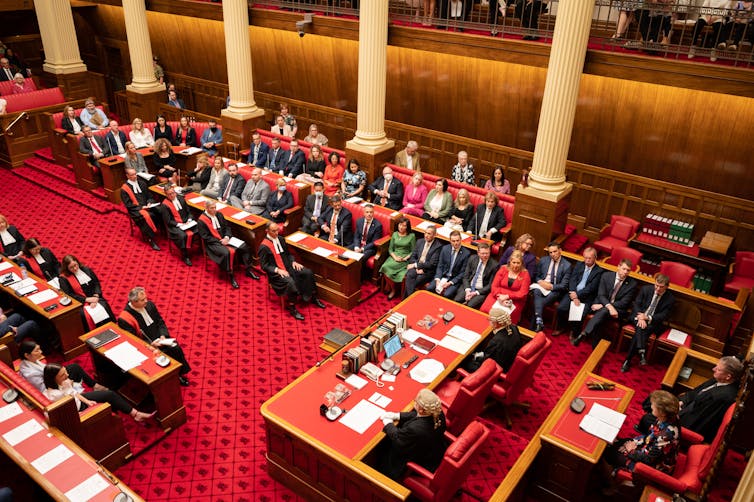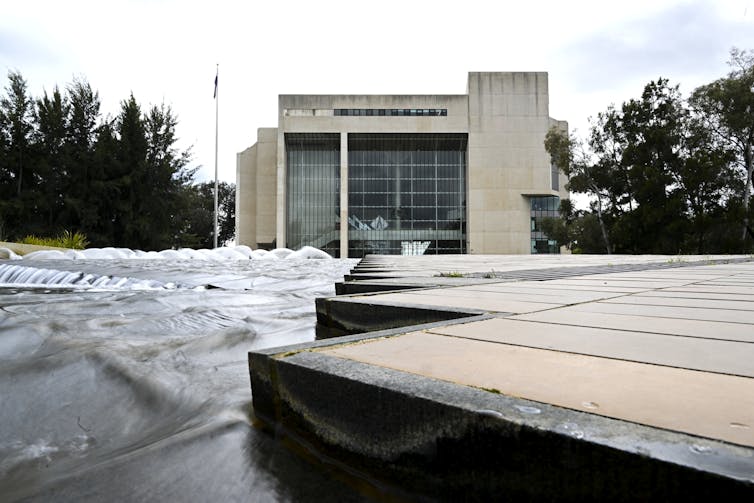The South Australian government has proposed banning political donations because of the risk and the perception that they buy undue influence and fuel corruption. Premier Peter Malinauskas said the aim was to “give South Australians confidence that decisions are being made because they’re the right thing to do”, rather than reciprocation for donations.
Malinauskas also said legislation had been challenging to draft, with much thought given to how it would hold up if tested in the High Court.
So what is this law proposing? How likely is it to withstand legal challenges? And what might it mean for democracy?
What would the law do?
The proposed law would ban political parties and candidates (other than new entrants) from receiving political donations. Instead, they would be provided with public funding for both campaigning and party administration. Campaign spending by political parties and candidates would be capped during the period prior to a state election to keep the cost of public funding down.
Political parties could still receive party membership fees of up to A$100 per member. This is intended to encourage parties to engage with the community and seek to broaden their membership. Otherwise, there is a real risk that if parties are fully supported by government handouts, they lose touch with the community.
Outside influence on campaigns
One of the biggest difficulties with political donation reform is the dilemma of how to treat third-party campaigners. These are the people and organisations that are not running for election themselves, but have a political interest to push. They include environmentalists, charities, miners, welfare groups, business groups, trade unions, pubs and clubs, and Indigenous bodies. If they spend more than a certain amount on political expenditure in the period prior to an election, they need to register.
Attempts to muzzle third-party campaigners, such as trade unions, from communicating their views during election campaigns have previously been struck down by the High Court. This is most likely why this new scheme would not place any caps on political donations to third parties or on their electoral expenditure. All third parties will have to do is meet disclosure requirements of donations, debts and spending. They will also have to use a “state campaign account” for receiving donations and for political expenditure.
The risk is once political parties and candidates are banned from receiving donations and have capped spending, political donations will instead flow to third parties, which can receive and spend as much as they like.
This gives significant political power to third-party interest groups, which can use their spending power to pressure parties and candidates to support their causes. It has the potential to distort election campaigns, with well-funded interest groups dominating the discourse and forcing political parties to dance to their tune.
A better approach may be to impose carefully calibrated expenditure caps on third parties, which allow them to communicate their political views effectively, but not to dominate the campaign at the expense of parties and candidates.
Rules around ‘associated entities’
When spending caps are applied, it is necessary to prevent parties from subverting them by establishing associated entities as third parties with their own separate caps, or in the South Australian case, no expenditure cap at all.
The proposed law prohibits arrangements between a political party and a third party to circumvent the expenditure cap. In addition, any donation to an “associated entity” is treated as a donation made to the party with which it is associated.
Controversially, the definition of an associated entity expressly excludes “registered industrial organisations” (trade unions). However, affiliation fees by trade unions are treated as donations and would fall within the donation ban.
ROY VANDERVEGT/AAP
Favouring the incumbents
Another problem with public funding schemes is that they are usually skewed towards major parties and incumbent politicians. This is because they are tied to the number of first-preference votes candidates receive and/or the number of seats a party wins at the election.
For example, once donations are banned, the SA scheme will provide funding for party administration between elections. Funding will be allocated to a registered political party according its number of MPs. The funding therefore not only favours incumbents, but also has the effect of favouring the government (which ordinarily has the most MPs) over the opposition and minor parties, even though all parties face many of the same administrative costs.
While 50% of this funding must be used for administration, the rest may be used for election expenditure. This effectively boosts the amount available to incumbent parties and favours the party that won the most seats at the previous election.
Independent MPs are given a smaller administrative assistance amount, which can be used for any purpose. In addition, MPs have staff and various allowances that give them a significant campaigning advantage.
New political parties and new independent candidates don’t get any of this support. Their only compensation is that they are exempt from the ban on political donations, so they can raise donations capped at $2,700.

Morgan Sette/AAP
There are also distinctions regarding advance funding for election campaigns. Under the SA scheme, registered political parties can claim a portion of their election campaign funding in advance, calculated by reference to first preference votes given to the party’s endorsed candidates at the previous general election.
As new entrants have no previous election results, they only have advance access to a relatively small fixed amount per endorsed candidate. They also cannot claim it unless they can list sufficient numbers of electors who endorse them (100 for a House of Assembly candidate and 500 for a Legislative Council candidate). If they don’t gain at least 4% of first preference votes at the ensuing election, they are entitled to no public funding at all.
Why does this matter? First, because a healthy democracy needs to accommodate newcomers, competition and disruption. A law that protects and supports existing parties only is likely to result in political stagnation and the loss of public engagement in politics.
Second, the High Court in the Australian Capital Television case struck down the validity of a law concerning political advertising on the grounds that it unfairly favoured incumbents. The law banned political advertising on electronic media, except for free political ads, 90% of which were allocated to parties with elected members, based on their proportion of first-preference votes at the previous election.

Lukas Coch/AAP
Only 10% of the free airtime was allocated to new and independent candidates. This was insufficient to save the law. Justice McHugh argued one cannot seek to justify a law as levelling the playing field if it “favours the sitting members and their political parties at the expense of the views of those who do not hold political power”.
Whether the SA scheme has done enough to support new entrants will be a matter for the High Court to assess if the scheme is challenged.
Constitutional challenges
Any law that has the effect of limiting political advertising is vulnerable to challenge for breaching the constitutionally implied freedom of political communication. In addition to the risk the law might be too skewed in favour of incumbents, the High Court has also previously struck down a law that sought to ban political donations from any organisation or person other than an enrolled voter.
In that case, however, there was a gap between the amount of public funding provided and the expenditure cap, which the party had to fund, including by donations. Whether a ban that goes even further (prohibiting all political donations) would be valid may depend upon the relationship between the expenditure cap and the various types of funding payable to parties, independents and new entrants.
Read more:
Political donations rules are finally in the spotlight – here’s what the government should do
Could this happen federally?
The federal government has signalled its interest in electoral reform. We don’t yet know its plans.
But one of the advantages of the federal system is reform experiments can be undertaken by states on a smaller scale. The rest of the country can then see whether they work and should be adopted elsewhere.
The SA proposal is one such experiment. If it passes, survives any constitutional challenges and fulfils its aims, others may well adopt it. But it needs to prove itself first.

